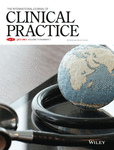Risk of hypercalcemia in patients with very high serum 25-OH vitamin D levels
Abstract
Objective
We aimed to evaluate the risk of hypercalcemia in patients with very high levels of 25-hydroxy vitamin D (25(OH)D).
Methods
The distribution of patients who were screened for 25(OH)D in our hospital between January 2014 and December 2018 was evaluated and patients with serum concentrations of 25(OH)D >88 ng/mL were selected. Then, biochemical parameters of the cases with 25(OH)D >88 ng/mL were compared according to calcium status, vitamin D level (group 1, 88-100 ng/mL; group 2, 100-150 ng/mL, and group 3, >150 ng/mL), and gender.
Results
A total of 282 932 patients who underwent 25(OH)D tests in our hospital were evaluated. A total of 1311 (0.5%) patients had very high 25(OH)D levels (>88 ng/mL). Four hundred and ninety-five patients who met our inclusion criteria and had complete data participated in the study. The median age was 58 years (interquartile range [IQR] = 41-71 years) and the median level of 25(OH)D was 104.6 mg/mL (IQR = 94.9-124.9 ng/mL). Most of the subjects (83.7%) with very high 25(OH)D levels were normocalcemic. A weak inverse correlation was observed between 25(OH)D level and intact parathyroid hormone (iPTH) level (r = −0.118, P = .01), but no correlation between 25(OH)D and calcium levels was observed. Alkaline phosphatase (ALP) levels were significantly higher in males (P = .032), and age and iPTH levels were higher in females (P < .001 and P = .004). ALP, phosphorus levels, and iPTH suppression rates were higher in hypercalcemic patients (P < .001, P < .001, and P < .001, respectively), while the iPTH level was significantly lower in hypercalcemic patients (P < .001) than in normocalcemic patients. Amongst the three groups with different 25(OH)D levels, no difference was found in levels of iPTH, calcium, phosphorus, ALP, or age.
Conclusion
Most patients with very high vitamin D levels were normocalcemic, but severe hypercalcemia was also observed. Vitamin D replacement therapy and follow-up should be performed according to clinical guideline recommendations.
DISCLOSURES
The authors declare that they have no conflict of interest.
Open Research
DATA AVAILABILITY STATEMENT
The data that support the findings of this study are available on request from the corresponding author. The data are not publicly available due to privacy or ethical restrictions.




